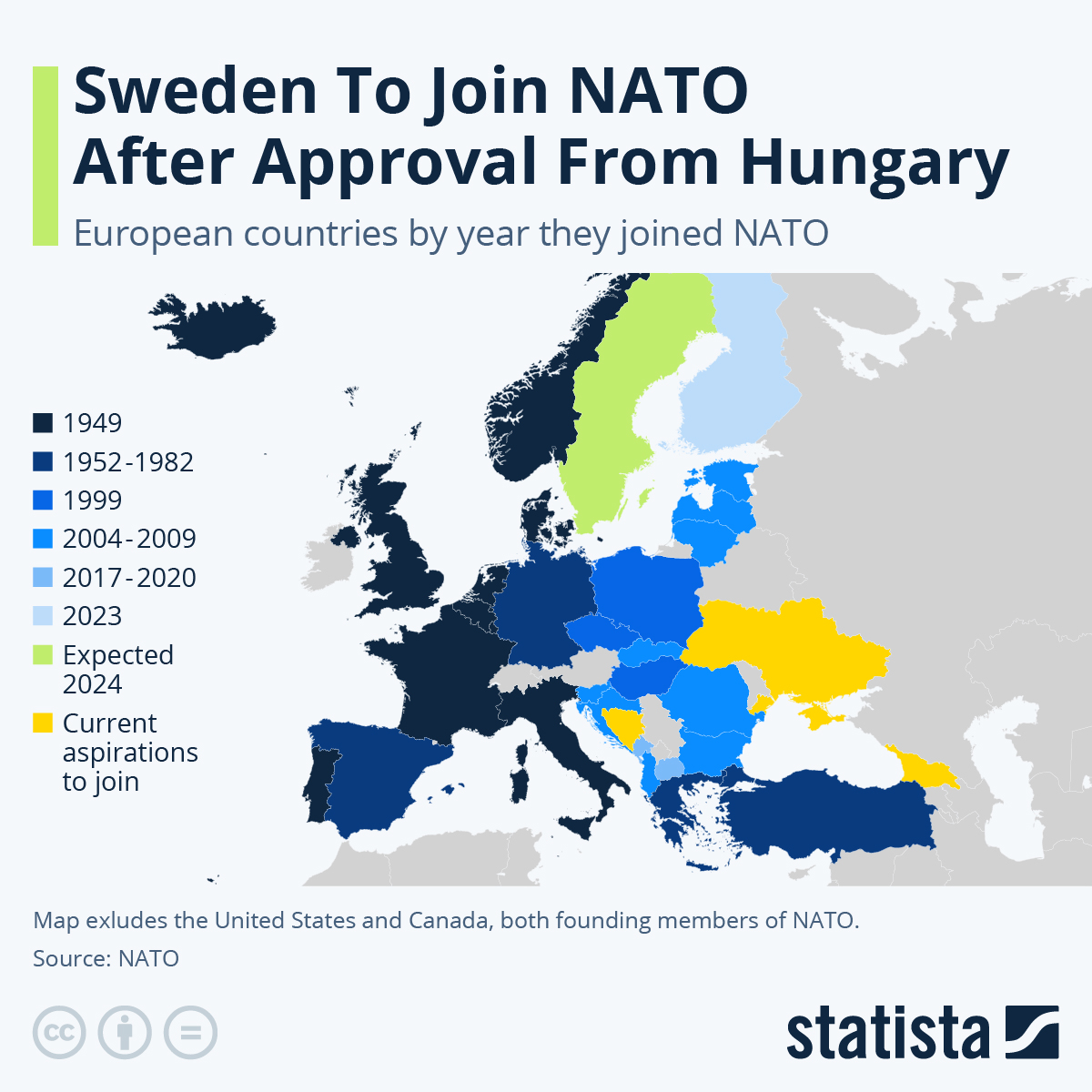Defense & Security in the European Union - Statistics & Facts
In fact, Europe's defense policy is highly integrated with that of the United States within the framework of the North Atlantic Treaty Organization (NATO), with 22 EU states being signatories of the treaty, while Sweden is currently negotiating entry into the organization. Only Ireland, Austria, Malta, and Cyprus remain militarily non-aligned (sometimes referred to as being a 'neutral' country) within the EU, with Finland becoming the most recent member state to join NATO in 2023, in reaction to Russia's invasion and war of aggression in Ukraine. Russia's re-emergence as a military power and its increasingly aggressive foreign policy towards its neighbors has changed many EU countries' stance on military matters, with Germany in particular going through what Chancellor Olaf Scholz referred to as a Zeitenwende - a turning point or critical juncture - which has reoriented the country towards pursuing a stronger defense policy at the national, EU, and NATO levels.
A short history of European defense policy
The European Union as a political entity has its roots in war and conflict, with the origins of the union lying in post-World War II economic cooperation between the countries of Western Europe. A core idea of the EU since its founding has been that the economic, legal, and political integration of countries on the European continent makes conflict less likely, if not impossible, due to the shared incentives for cooperation. This was particularly a concern of French and German policymakers, as the two countries had fought each other three times in less than a century (1870-71, 1914-18, and 1939-45) by the time of the founding of the European Economic Community with the Treaty of Rome in 1957. In this sense, the European project has been highly successful, with no member states or candidate states being involved in an armed conflict with each other since its founding.The idea of how the EU should conduct itself in defense & security issues with respect to the rest of world, however, has been much less clearly defined. This is particularly the case due to Europe's historical reliance on the United States as its key ally for security. This security provided by the U.S. comes through the North Atlantic Treaty Organization (NATO), a military alliance involving 23 of 27 EU member states, as well as former member the United Kingdom. At its core the pledge through Article 5 of the NATO treaty states that should one member be attacked, all other members are obliged to come to its assistance. This security guarantee is backstopped by the fact that the United States has one of the world's largest, most powerful, and by far the most highly funded military, with the U.S.' nuclear capabilities making it unlikely that another country would attack a NATO member.

The EU's role in European defense
Co-operation within the European Union on foreign and defense policy has developed gradually, as these were traditionally policy areas seen as being the prerogative of member states. In 1999, the European Security and Defence Policy was introduced, known as the Common Security and Defence Policy (CSDP) since the 2007 Lisbon Treaty, providing the structure which exists on defense matters in the EU up to the present day. Denmark became the latest member state to join the CSDP in 2022, as the country voted in a referendum to relinquish its opt-out for cooperation on military matters in the EU, due to Russia's invasion of Ukraine. The Lisbon Treaty also added a mutual defense clause to EU membership, meaning that, similar to NATO Article 5, if one member of the union is attacked, the other member states are required to come to their assistance militarily. While binding for all member states, this clause does not affect the military neutrality of Austria, Ireland, and Malta. Permanent Structured Cooperation (PESCO) has been the policy of 26 of the 27 member states since 2017 (Malta has chosen to abstain), which seeks structural integration of the armed forces of all member states, with this policy being promoted by the European Defence Agency (EDA).Regional defense & security priorities of EU member states
The priorities of EU member states in regards to their defense and security differ widely by the region in which they find themselves. European Union countries which have borders with Russia, namely Finland, Estonia, Latvia, Lithuania, and Poland, along with countries that had a history of occupation by the Soviet Union, such as Czechia, Slovakia, Hungary, Romania, and Bulgaria, generally are highly concerned with the EU's defense vis-a-vis Russia. This is visible in their high levels of support for Ukraine since Russia's invasion in 2022, although some countries, such as Bulgaria, have sizeable portions of their populations and political classes with sympathies for the Kremlin.Countries in western Europe who had colonial empires sometimes retain security responsibilities in these regions or countries. France, one of Europe's largest militaries, is often involved in foreign conflicts in its former colonies in western Africa, where Islamist groups have destabilized many governments in recent decades, notably in Mali. Sweden and Finland, both neutral countries for most of the period since World War II, have changed their defense policies in light of the war in Ukraine, applying for NATO membership in 2023, with Finland already having been admitted as the alliance's 31st member. The countries of southern Europe have become involved the fortification of their borders due to increasing migration flows from west Asia and north Africa, with Spain, France, Italy, and Greece, maintaining large naval forces to police their waters in the Mediterranean Sea.


































































